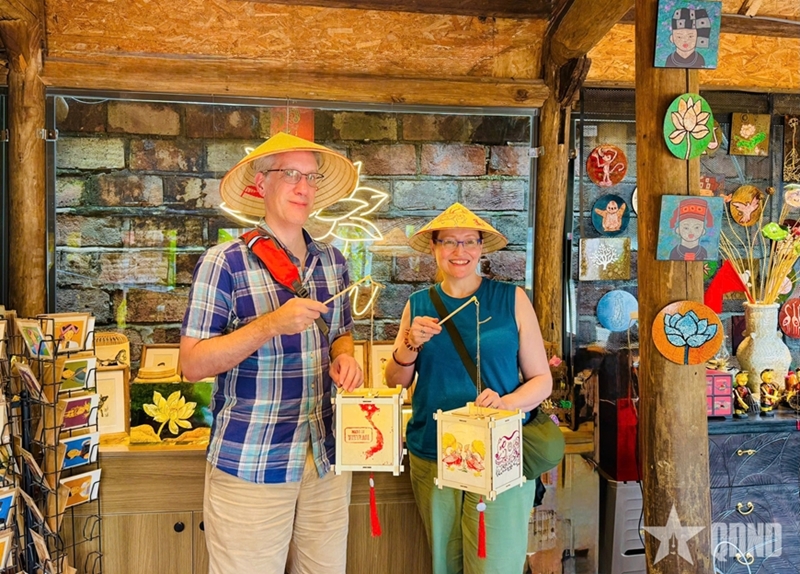Johan Meier, aged 29, a tourist from Switzerland, spent three weeks traveling Hanoi, Ha Long, Hoi An and Ho Chi Minh City. Thanks to the visa exemption, his passport check, stamping, and immigration procedures at Noi Bai International Airport went smoothly. He has visited Thailand and Singapore, which have had visa-free policies for international tourists for a long time and attracted a huge number of visitors. Therefore, the Swiss tourist shared, “for long-stay travelers like me, Vietnam’s 45-day visa exemption is very appealing, giving me more opportunities to experience local culture.”
    |
 |
|
International tourists experience making lanterns at the Temple of Literature in Hanoi. |
According to the World Tourism Organization, visa exemptions can help increase international arrivals by 5% to 25%. Most countries around the world have adopted visa-free or flexible visa policies to attract tourists. In Southeast Asia, Malaysia has the region’s most open visa policy, exempting visas for citizens of 165 countries and territories, followed by Singapore (163), and Thailand (98). These countries have also extended the length of stay to 30-90 days, allowing tourists to spend more time. As a result, Malaysia, Singapore, and Thailand have attracted significant tourist flows. In 2024, Malaysia recorded 37 million arrivals, while Thailand welcomed over 35 million, surpassing its pre-Covid-19 figure of 31 million in 2019, as revealed by the Thai Ministry of Culture, Sports and Tourism.
Vietnam is also becoming increasingly open with its visa policy. Recently, the Government issued Resolution No.229/NQ-CP on visa exemption to stimulate tourism development for citizens of 12 countries, namely Belgium, Bulgaria, Croatia, the Czech Republic, Hungary, Luxembourg, the Netherlands, Poland, Romania, Slovakia, Slovenia, and Switzerland. Citizens of these countries are granted 45 days of temporary stay from the date of entry for tourism purposes, regardless of passport type, provided they meet Vietnam’s entry requirements. The policy is valid from August 15, 2025, to August 14, 2028.
A friendlier visa policy will not only help Vietnam attract more international conferences, exhibitions, and events, but also create favorable conditions for business travelers and tourists. This means that apart from the tourism industry, other economic sectors, such as aviation, transport, retail, and services will also benefit.
According to the latest report from the General Statistics Office, thanks to the more open visa policy, boosted tourism promotion programs, and major national celebrations, international arrivals to Vietnam are on the rise. In July 2025, Vietnam welcomed 1.56 million international visitors, up 6.8% from the previous month and 35.7% year-on-year. In the first seven months of 2025, international arrivals reached 12.23 million, an increase of 22.5% compared to the same period last year.
In a conversation, Dr. Nguyen Duc Trong, instructor at the Faculty of Tourism and Hospitality of the National Economics University, said that the newly issued visa exemption policy is the ‘key’ to enhancing competitiveness of Vietnam’s tourism in the region. According to him, natural beauty alone is not enough to surpass other countries. The real difference comes from convenient experiences, and visa is the first barrier to remove. “When visitors find entry procedures simple, they are willing to stay longer, spend more, and thus bring much greater economic value compared to visa fees,” Dr. Trong said.
To enable Vietnam’s tourism industry to truly make breakthroughs and develop sustainably, expanding and improving visa policies should be a priority. Alongside removing visa barriers, Vietnam needs to continue strong investment in tourism infrastructure and transport connectivity, enhance professional destination marketing, and diversify tourism products to meet market demands. Improving service quality, developing professional human resources, protecting the environment, and promoting green tourism are also crucial to bring a complete experience to visitors. When these solutions are implemented synchronously, the visa policy will not only serve as an “open gateway” to welcome international tourists but also become a strategic driver to elevate Vietnam’s tourism to new heights.
Translated by Mai Huong